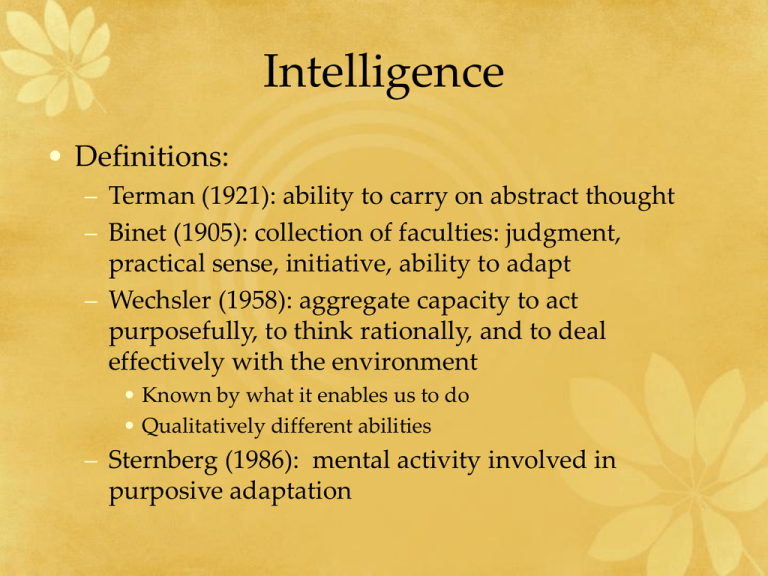Intelligence • Definitions:
advertisement

Intelligence • Definitions: – Terman (1921): ability to carry on abstract thought – Binet (1905): collection of faculties: judgment, practical sense, initiative, ability to adapt – Wechsler (1958): aggregate capacity to act purposefully, to think rationally, and to deal effectively with the environment • Known by what it enables us to do • Qualitatively different abilities – Sternberg (1986): mental activity involved in purposive adaptation Theories of Intelligence 2 major schools of thought: 1. One general factor, g • Spearman 2. Different types of intelligence (disagreement about what those are) • Sternberg, Gardner, Thurstone One general factor theory • Spearman’s g – – – – Used factor analysis g = general mental ability Complicated mental activities are highest in g Specific factors may also be included One General Intelligence Support for this approach: 1. Positive manifold – high correlations between different tests of cognitive ability 2. Neural processing speed i.e. speed of processing Different factors approach to intelligence • Thurstone: – – NOT a unitary trait Differing types of abilities: 1. 2. 3. 4. 5. 6. 7. 8. Verbal Perceptual speed Inductive reasoning Numbers Rote memory Deductive reasoning Word fluency visualization Alternative theories of multiple intelligences • Gardner’s theory: – 7 different forms of intelligence • Linguistic – use of language • Musical – rhythm, pitch • Spatial – perceiving visual world • Bodily – kinesthetic awareness, movement • Interpersonal – knowledge of others’s moods, motivations, etc. • Intrapersonal – knowledge of self, feelings • Logic-mathematical – logical thinking, numerical ability Another theory of multiple intelligence • Fluid & Crystallized intelligence (Horn) – Fluid = basic reasoning ability, ability to learn • Nonverbal mental efficiency • Strong physiological base – Crystallized = acquired skills and knowledge • Knowledge of general information • Influenced by education and culture One more theory of multiple intelligences • Sternberg: 3 dimensions of intelligence 1. Analytical – internal mental mechanisms – Mental processes – – – 2. Creative (experiential)– intelligence related to novel stimuli – – 3. Used to learn new things Execute behavior Higher-order processing such as planning, monitoring, and evaluating Ability to apply existing knowledge to new problems Implication: our experiences impact our IQ. Very difficult to compare people across sociocultural groups due to differences in experience. Practical (contextual) – IQ related to external world – – Ability to deal with everyday tasks i.e. not just academic or book learning


